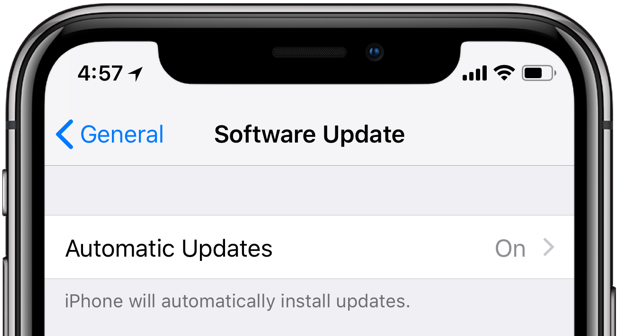There’s a new iOS update available but your iPhone hasn’t updated itself for days, or even weeks now, even though the automatic updates option has been turned on? Apple has an explanation for why automatic software updates are often delayed by up to a month. To make a long story short: It’s a feature, not a bug.

- iPhone user Mateusz Buda emailed Apple’s software head Craig Federighi about automatic iOS updates arriving several weeks late. In the message, Mateusz also asked Craig to explain how exactly this feature is supposed to work.
- Some folks do complain that the auto-update feature in iOS, iPadOS and macOS seems to be weeks behind schedule. It often takes days or even weeks, people are saying, for an operating system update to automatically download and install even though it shows up immediately when checking for updates manually.
- Apple says this is by design. By releasing a major iOS update in stages rather than pushing it at once to everyone’s devices that have the auto-update option turned on, Apple not only eases load on its own servers but also ensures that any potential teething issues are limited to early adopters.
Why automatic iOS updates are delayed by 1-4 weeks
iPhone user Mateusz Buda wrote the following in his email to Apple’s Craig Federighi:
I went on holiday at the end of January, just two days after installing iOS 15.3 on my iPhone. But to this date I haven’t received a notification about the latest iOS 15.4 update even though I have automatic updates (both downloading and installing) turned on in Settings. Yesterday was two weeks after the public release of iOS 15.4. Of course I use my iPhone as always (connected to Wi-Fi, not using low-power mode etc.) so the feature could have at least downloaded the iOS 15.4 update automatically.
And here come the key questions:
How exactly do automatic updates work? What conditions must be met for this function to work? Automatic app updates do work—it takes like three days maximum for the app to update itself so no problems there.
Here’s Craig’s response, via Reddit:
Hi Mateusz,
We incrementally roll out new iOS updates by first making them available for those that explicitly seek them out in Settings, and then 1-4 weeks later (after we’ve received feedback on the update) ramp up to rolling out to devices with auto-update enabled.
Hope that helps!
Craig
The feature’s description spells out that automatic updates are installed overnight after they have been downloaded. The key thing to keep in mind: The downloaded update won’t actually install unless your iPhone is plugged into power and connected to the internet. Automatic updates also don’t work if low-power mode is turned on. Read: How to download App Store apps that are unavailable in your country
Preventing servers from melting down
Staggered rollouts have become the norm. Often, a popular app such as Instagram or TikTok or Twitter would announce the immediate availability of a new feature and people would wonder why they’re not seeing it at once. And that’s precisely why we tell you when writing about such updates to check back “a few days or weeks later” if the feature doesn’t show up on your devices. Automatic iOS updates are similar in that regard. Read: How to update apps on iPhone, iPad and Apple Watch
With nearly two billion active devices out in the wild, it’s reasonable for a big company like Apple to take all necessary precautions to prevent any potential server issues from occurring. If Apple pushed automatic updates to all users at once, its servers could melt under heavy load. And slow servers would inevitably reduce your download speed drastically, ruining the whole iOS update experience.
Assuring initial bugs are limited to early adopters
To deliver staggered iOS updates, Apple segments the user base into two camps.
In the first camp are your early adopters who do not have the automatic updates option turned in Settings. They are the kinds of people who like to live on the bleeding edge of technology so they would be the first to manually run Software Update on the first day an iOS update is released to the public. In the second camp are people who have turned on automatic updates in Settings → General → Software Update. Those are your regular Joes, not early adopters.
In case of a botched iOS update or an iOS update containing a nasty bug that couldn’t be found during beta-testing, early adopters will take most of the pain. Everyone else (people with automatic iOS updates turned on) will be protected because the update has yet to be downloaded on their devices.
OK, but why are app updates pending?
Craig’s response does not address app updates. Even with automatic downloads turned on for app updates in Settings → App Store, app updates can show as pending in the App Store for weeks. Some people have reported the auto-update mechanism actually never updating the installed apps—even when the device is plugged into power and connected to Wi-Fi all the time.
While Mateusz didn’t ask Craig about app updates, it’s reasonable to assume the same answer: Automatic app updates are delayed to both prevent servers from being overloaded and kill the update in case of a critical issue before it’s automatically pushed to everyone’s devices. And like with iOS updates, early adopters can install app updates at any time by hitting their Apple ID profile image in the App Store. Read: How to fix slow App Store downloads on iPhone, iPad and Mac